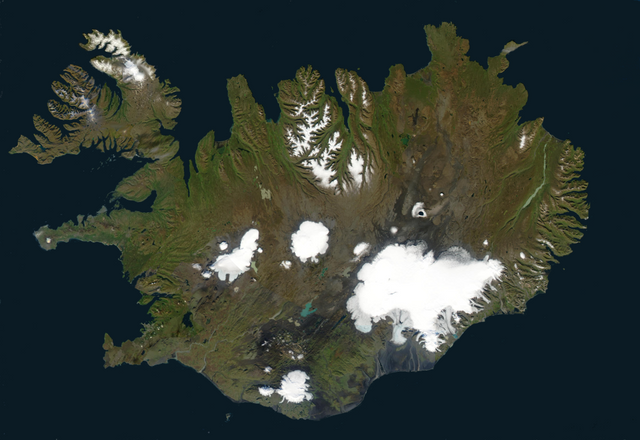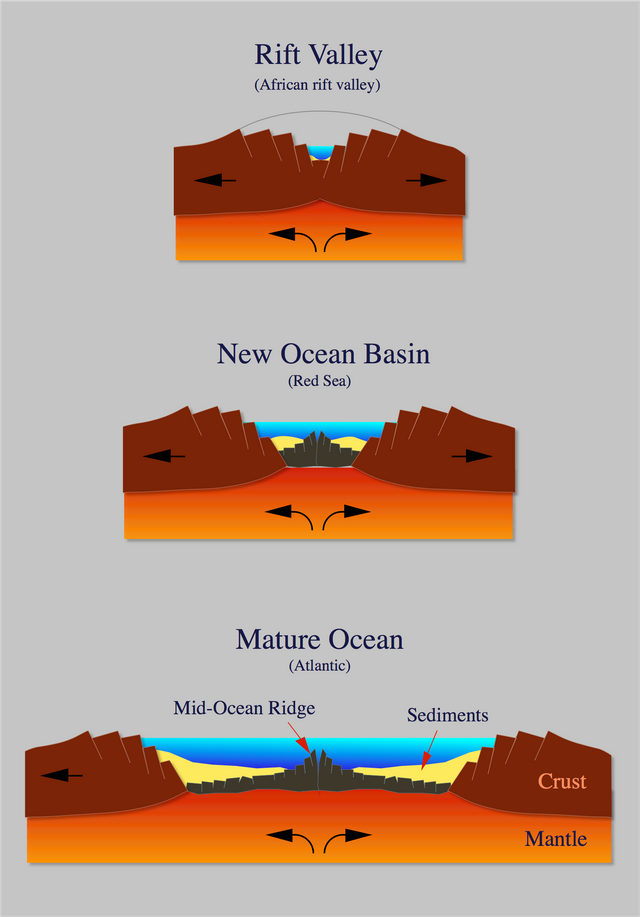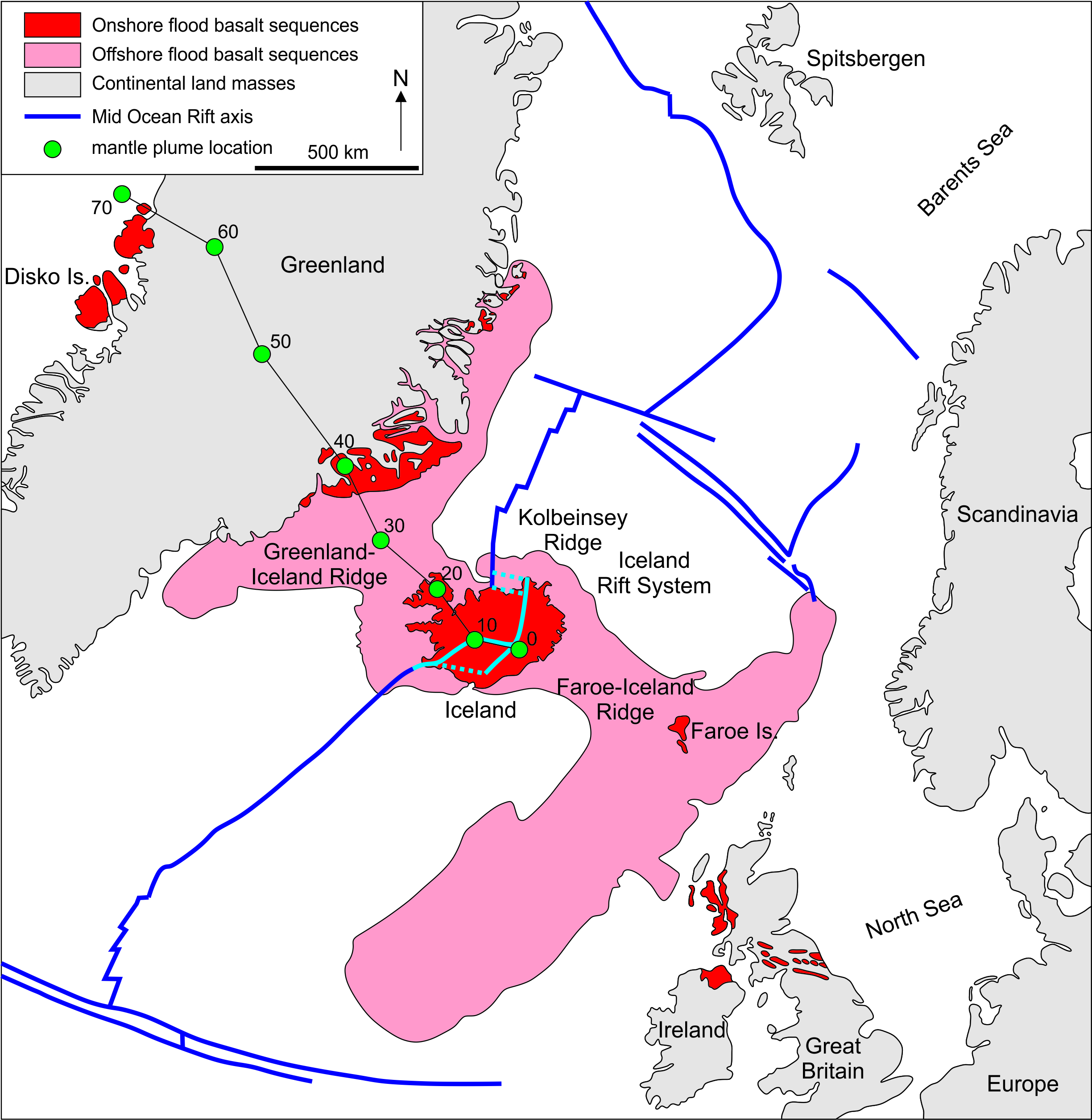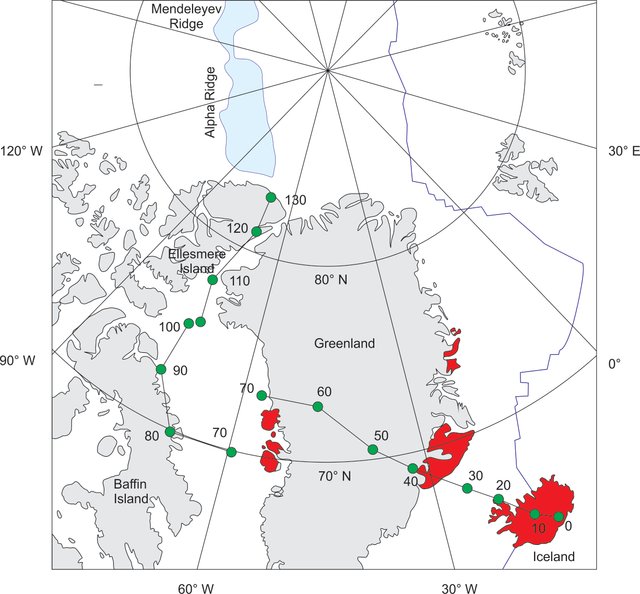Geology of Iceland - Part 2: The Iceland hotspot
Iceland is located in the center of the North Atlantic Ocean. The Formation of Iceland is a beautiful interplay of two major crust forming processes that come together to produce this wonderland.

Iceland from space.
commons.wikimedia.org
Mid Ocean Ridge
The process that made the formation of Iceland possible was the continental breakup that separated Newfoundland and Greenland from Europe. This process subsequently formed the sea floor that now surrounds Iceland. Prior to this event the continents on both sides of the North Atlantic were merged in a continuous landmass. They stayed a unified mass for over 300 million years until about 70 million years ago this large continent began to break up along a fracture zone extending from the latitudes of Newfoundland-British Isles northwards into the Arctic between Scandinavia and Greenland. As the continent on either side of the fracture drifted apart, a new plate boundary was formed.
Today, this plate boundary is where active spreading and plate growth take place. Right along it the crust is being pulled apart and magma escapes from the underlying mantle to fill in the gap. Continuous spreading lead to the continuous upwelling of magma and over millions of years, this process gradually produced the oceanic crust beneath the North Atlantic that surrounds Iceland. The size of the North Atlantic Ocean might be misleading towards the speed of this process. As mentioned, it took millions of years to form the ocean floor and the actual spreading rate is around 2 cm/year (1 cm/year in each direction). The suture zone in this particular case is the Mid-Atlantic Ridge, where the American plate (to the west) and the Eurasian plate (to the east) are actively being pulled apart. Such mid-ocean ridges are found in all of the major oceans on Earth.

Sketch showing the different steps in the birth of a Mid-Ocean Ridge.
commons.wikimedia.org
The Icelandic hotspot
Now the question arises, if those spreading ridges are separating every ocean on the planet, why is only Iceland emerging from the depths above the ocean surface? Usually, mid-ocean ridges never build up high enough to rise above the sea level, but in Iceland they do. This happens, because at Iceland, more eruptions occur, than usual for such a tectonic setting. The reason for this is that in addition to being an active plate boundary, Iceland is also underlain by a hot spot. The hotspot is produced by a plume of hotter and less dense material within the earth’s mantle, similar to the processes we have already seen in Hawai’i. It is termed the Iceland mantle plume. The plume is not a recent occurrence, but it has been active for millions of years and even pre-dates the opening of the North Atlantic. Some geologists believe the separating tectonic plates enabled the mantle plume to find its way upward, whereas others believe the rising plume caused the plates to separate.
Different from the observation in Hawai’i, the Icelandic hotpot’s path is not documented by a continuous volcanic chain with an associated age progression.
On Iceland itself, the oldest volcanic rocks are 16 to 22 million years old and are found at the eastern and western coasts. This is expected on an island formed above separating tectonic plates. Flows below sea level, both eastward and westward, are still older. The flows continue along the ocean floor and emerge again on the west coasts of Scotland and Ireland and the east coast of Greenland and provide clear evidence of the opening of the North Atlantic Ocean. Those rocks are 40 to 50 million years old.
In its entirety, this volcanic series is known as the North Atlantic Large Igneous Province. It is approximately 2000 km long and it represents about 10 million cubic kilometers of magma that has emerged formed the Iceland mantle plume through volcanic activity over 65 million years. This figure is roughly 50 times the volume of Iceland.

Map showing the extend of the Iceland Basalt Plateau representing the North Atlantic Large Igneous Province, located in the middle of the North Atlantic. Emerged parts are shown in red and submerged parts are shown in pink. Blue lines represents Mid Ocean ridges. Green circles represent the location of the Iceland mantle plume in 10 Ma increments.
Modified after Saunders et al. (1997)
But the two sides of the North Atlantic Ocean are not the only places on-shore lavas created by the Iceland mantle plume can be found.
Volcanic rocks exposed on the other side of Greenland, along the west coast, are about 70 million years old and are also believed to have been created by the Iceland mantle plume. This leads to the assumption that Greenland must have been located above the plume between 40 and 70 million years ago. Here, rock outcrops are inaccessible due to the thick ice cover.
The Alpha and Mendeleyev Ridge in the Arctic Ocean are around 130 million years old and some scientist have suggested that they represent an early expression of the Iceland mantle plume. Using plate reconstruction data available from other stationary hotspots around the globe, they were able to reconstruct the path of the continental land masses across the Iceland mantle plume beyond 70 million years. The path shows that during this period first Ellesmere Island and then Baffin Island were over the plume. This might be evidence that the Iceland plume is at least twice as old as initial opening of the northernmost Atlantic.

Map showing the extend of the synthetic Icelandic hotspot track. On-shore basalts are shown in red. Ridges are shown in blue. Green circles represent the location of the Iceland mantle plume in 10 Ma increments.
Modified after Lawver and Müller (1994)
Previous posts
Geology of Iceland – Part 1: Introduction
References
- Lawver, L.A. and Müller, R.D. (1994). Iceland hotspot track. Geology 22, 311-314
- Thordarson, T. and Höskuldsson, Á. (2014). Classic Geology in Europe 3: Iceland. Second Edition. Dunedin Academic Press Ltd, 256 pp.
- Saunders, A.D., Fitton, J.G., Kerr, A.C., Norry, M.J., Kent, R.W., 1997. The North Atlantic Igneous Province. In: Mahoney, J.J., Coffin, M.F.
(Eds.), Large Igneous Provinces: Continental, Oceanic, and Planetary Flood Volcanism. Geophys. Monogr. 100. American Geophysical Union,
Washington, DC, pp. 45–93. - Zeilinga de Boer, J. and Sanders, D.T., (2002). Volcanoes in Human History: The Far-reaching Effects of Major Eruptions. Princeton University Press, 295 pp.

When I visited Iceland a few years ago the rocks and landscape were some of the most fascinating I've ever seen. I know very little about Geology so its good to get some background on all the cool stuff I remember from that trip.
It is one of my top travel destinations. And the flights are becoming fairly cheap. Just need to find some time. Maybe I have a decent list of must-see points after finishing this series to have a rough vacation planned :P
Very nice summary! I really like the final figure as it gives some indication of the rate of motion for the hot spot. It appears to have slowed over the past 30 million years as it crossed the Mid-Atlantic Ridge - I suppose the perfect geologic storm has allowed this fascinating island to exist.
Yes, the Atlantic mid ocean ridge is a slow spreading ridge. Its counterpart in the Pacific ocean spreads up to ten times faster. So it makes sense that the "plume locations" are closer together since the ocean opening.
I find it sad no one commented your post. It is super interesting and very clearly written (so that I don't have any question ;) ).
I actually always liked this kind of topic (volcanoes, tectonic plate motion, etc.), but I have never taken the time to read much about it! Thanks a lot!
My knowledge of modern volcanoes has always been only modest and I am so excited to have found motivation through steemit to actually do the in depth reading that those magnificent places deserve.
And I am happy to have other people appreciate my summaries. Thank you very much.
You are welcome! :)
You received a 80.0% upvote since you are a member of geopolis and wrote in the category of "geopolis".
To read more about us and what we do, click here.
https://steemit.com/geopolis/@geopolis/geopolis-the-community-for-global-sciences-update-4